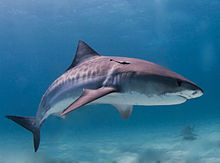
Back Tierhaai Afrikaans قرش ببري Arabic قرش ببرى ARZ Galeocerdo cuvier AST Pələng köpəkbalığı Azerbaijani Тыгровая акула Byelorussian Тыгровая акула BE-X-OLD Тигрова акула Bulgarian বাঘ হাঙ্গর Bengali/Bangla Rinkin-tigr Breton
| Tiger shark Temporal range:
| |
|---|---|

| |
| In The Bahamas | |

| |
| Scientific classification | |
| Domain: | Eukaryota |
| Kingdom: | Animalia |
| Phylum: | Chordata |
| Class: | Chondrichthyes |
| Subclass: | Elasmobranchii |
| Order: | Carcharhiniformes |
| Family: | Galeocerdonidae |
| Genus: | Galeocerdo |
| Species: | G. cuvier
|
| Binomial name | |
| Galeocerdo cuvier | |

| |
| Tiger shark range | |
| Synonyms | |
The tiger shark (Galeocerdo cuvier)[3] is a species of ground shark, and the only extant member of the genus Galeocerdo and family Galeocerdonidae. It is a large macropredator, with females capable of attaining a length of over 5 m (16 ft 5 in).[4] Populations are found in many tropical and temperate waters, especially around central Pacific islands. Its name derives from the dark stripes down its body, which resemble a tiger's pattern, but fade as the shark matures.[5]
The tiger shark is a solitary, mostly nocturnal hunter. It is notable for having the widest food spectrum of all sharks, with a range of prey that includes crustaceans, fish, seals, birds, squid, turtles, sea snakes, dolphins, and others, even smaller sharks. It also has a reputation as a "garbage eater",[5] consuming a variety of inedible, man-made objects that linger in its stomach. Tiger sharks have only one recorded natural predator, the orca.[6] It is considered a near threatened species because of finning and fishing by humans.[1]
The tiger shark is second only to the great white in recorded fatal attacks on humans, but these events are still exceedingly rare.[7][8]
- ^ a b Ferreira, L.C.; Simpfendorfer, C. (2019). "Galeocerdo cuvier". IUCN Red List of Threatened Species. 2019: e.T39378A2913541. doi:10.2305/IUCN.UK.2019-1.RLTS.T39378A2913541.en. Retrieved 19 November 2021.
- ^ "Galeocerdo cuvier". NatureServe Explorer. Retrieved 17 April 2024.
- ^ "ITIS Report – Galeocerdo cuvier". Integrated Taxonomic Information System!. Archived from the original on 3 March 2018. Retrieved 30 December 2015.
- ^ Cite error: The named reference
FroesePaulywas invoked but never defined (see the help page). - ^ a b Cite error: The named reference
SharkInfowas invoked but never defined (see the help page). - ^ Terrapon, Maeva; Venables, Stephanie K.; Lokker, Anthony; Bertrand, Nils; Hooker, Sascha K.; Marshall, Andrea D. (2024). "Killer Whale Predation on a Giant Manta Ray (Mobula birostris), a Sicklefin Devil Ray (Mobula tarapacana) and a Tiger Shark (Galeocerdo cuvier) in the Southwest Indian Ocean". African Journal of Ecology. 62 (4): e13342. doi:10.1111/aje.13342. ISSN 1365-2028.
- ^ Cite error: The named reference
flmnhwas invoked but never defined (see the help page). - ^ "Yearly Worldwide Shark Attack Summary". floridamuseum.ufl.edu. Archived from the original on 2021-06-11. Retrieved 2021-06-11.

